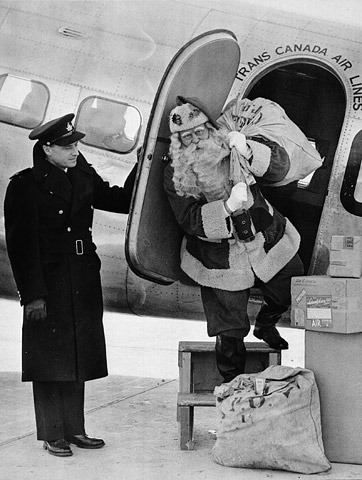By Dalton Campbell
On December 25, 1927, a Fairchild aircraft flew along the north shore of the St. Lawrence from La Malbaie to Sept-Îles, Quebec. As the plane approached each town, the pilot lowered the altitude of the aircraft and threw out a packet of mail attached to a parachute. The postmaster retrieved the parachute and mail as the pilot flew to the next town.
This was the first official Post Office air mail delivery for the communities along the north shore of Quebec. In the winter, these communities—like many others throughout Canada—had been isolated with irregular mail delivery arriving after slow transport by boat or dogsled.

Reknowned pilot Roméo Vachon at the doors of the Fairchild FC-2W aircraft of Canadian Transcontinental Airways Ltd. inaugurating airmail service between Montreal and Rimouski, Quebec, May 5, 1928. The mail was transferred from transatlantic ships at Rimouski and flown to Montreal and then to Toronto, saving 24 hours in delivery. (MIKAN 3390347)
At the time, mail was the primary means of receiving personal and commercial correspondence, newspapers, money transfers, parcels, and holiday presents. Canada was an ideal place to begin air mail with its large land area, small population, lack of communication links, and long winters.
The first official airmail flight in Canada had been in 1918. However, from 1918 to 1927 the majority of airmail delivered was aboard unofficial flights—either stunts, exhibitions, or private corporations (generally mining companies) delivering mail to their own operations. In 1927, the Post Office started to grant airmail contracts in larger numbers and began to create what would become a network of airmail routes. The end of 1927—Vachon’s run included—could be said to mark the end of the first year of official airmail in Canada.

An example of the unofficial air mail stamps created by private corporations for air mail delivery, 1926. Patricia Airways and Exploration operated flights and services between Sioux Lookout, Pine Ridge, and Red Lake, Ontario. (MIKAN 3854727)
These early official airmail contracts were granted by the Post Office to private airlines. By the spring of 1930, air routes were serving northern regions (e.g. Chibougamau, Quebec; Red Lake, Ontario), islands (e.g. Prince Edward Island; Pelee Island, Ontario; Îles-de-la-Madeleine, Quebec) and cities and towns throughout Canada.

The inaugural airmail delivery from Edmonton, Alberta, to Saskatoon, Saskatchewan, made by a Fokker F. XIV aircraft, Western Canada Airways Ltd. (later known as Canadian Airways), Saskatoon, March 3, 1930. (MIKAN 3390448)
Edmonton, “the gateway to the north,” was the starting point for postal delivery to the Northwest Territories. Previously, the post had been carried by boat in summer and by dogsled in winter to the communities along the Mackenzie River. Airmail cut the delivery time from weeks to days. After C.H. “Punch” Dickins of Western Canada Airways made the first airmail flights into the Arctic in January 1929, the Post Office contract was granted to Commercial Airways. The first official Arctic airmail was delivered by Wilfrid “Wop” May and Idris Glyn-Roberts in late December 1930.

Transferring the mail from airplane to dogsled after delivery to Aklavik, Northwest Territories, 1930. Pictured are pilots Wilfrid “Wop” May and Idris Glyn-Roberts beside their Bellanca Pacemaker, Commercial Airways. (MIKAN 3383375)
Most of the early pilots were veterans of the First World War. In Canada they flew hundreds of miles without charts, radio, or heated cabins, through snowstorms and fog, landing and taking off from water, ice, and other improvised airfields. The engineers and mechanics were equally heroic and now largely forgotten. They maintained the planes in extreme winter cold, often heating the engine oil each morning on a burner so the engine could start again. Library and Archives Canada’s Post Office Department fonds contains a report that an engineer climbed from an aircraft cabin in mid-flight to adjust a landing ski.
By the early 1930s, the value of airmail was evident. The service provided faster and more economical delivery, improved communication and commerce, and helped outlying regions and communities feel more closely tied to the rest of the country.

The first consignment of airmail by Trans-Canada Air Lines to Winnipeg, Manitoba, 1939. (MIKAN 3649847)
Related sources:
- Wilfrid Reid May fonds
- Romeo and Georgette Vachon fonds
- Richard Kenneth Malott fonds
- Emil J. Fiala collection
- Stanley Ransom McMillan fonds
- Post Office Department fonds
- Air Services Division sub-series, Post Office Department fonds
Dalton Campbell is an archivist in the Science, Environment and Economy Section of the Private Archives Division.

This is a very good article. I have a postal cover from Halifax cancelled 31 Jan 1931 to Aklavik NWT, and it is annotated FIRST INTERNATIONAL TRANSCONTINENTAL AIR MAIL TRANSFER. NOVA SCOTIA – AKLAVIK NWT. It is backstamped Edmonton 5 Feb 1931 and very faint Aklavik NWT. I am not able to find any info on it, and wondered if anyone might be able to tell me anything about it? Thank you,
Hello Mr. McDermid,
I suggest that you send your question through our the Ask us a question form found here: http://www.bac-lac.gc.ca/eng/assistance-request-form/Pages/assistance-request-form.aspx?requesttype=3
The question will be forwarded to the stamp specialist through the right channels.
Good luck!